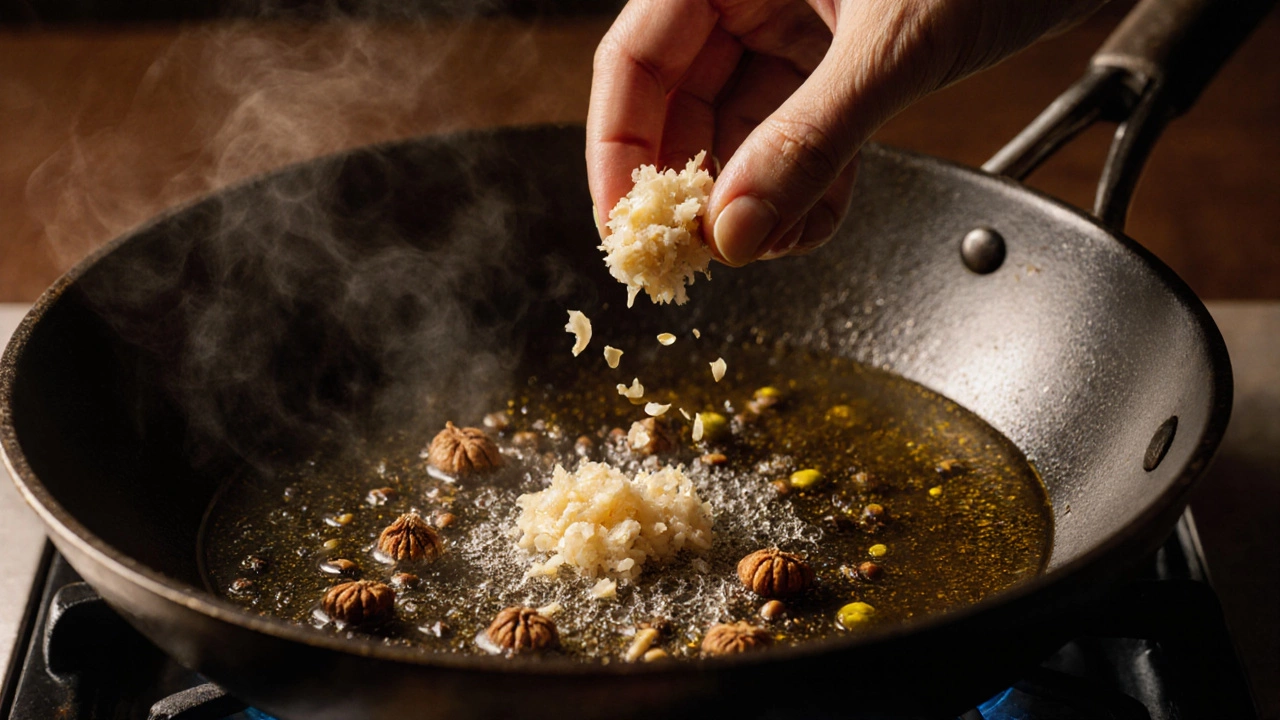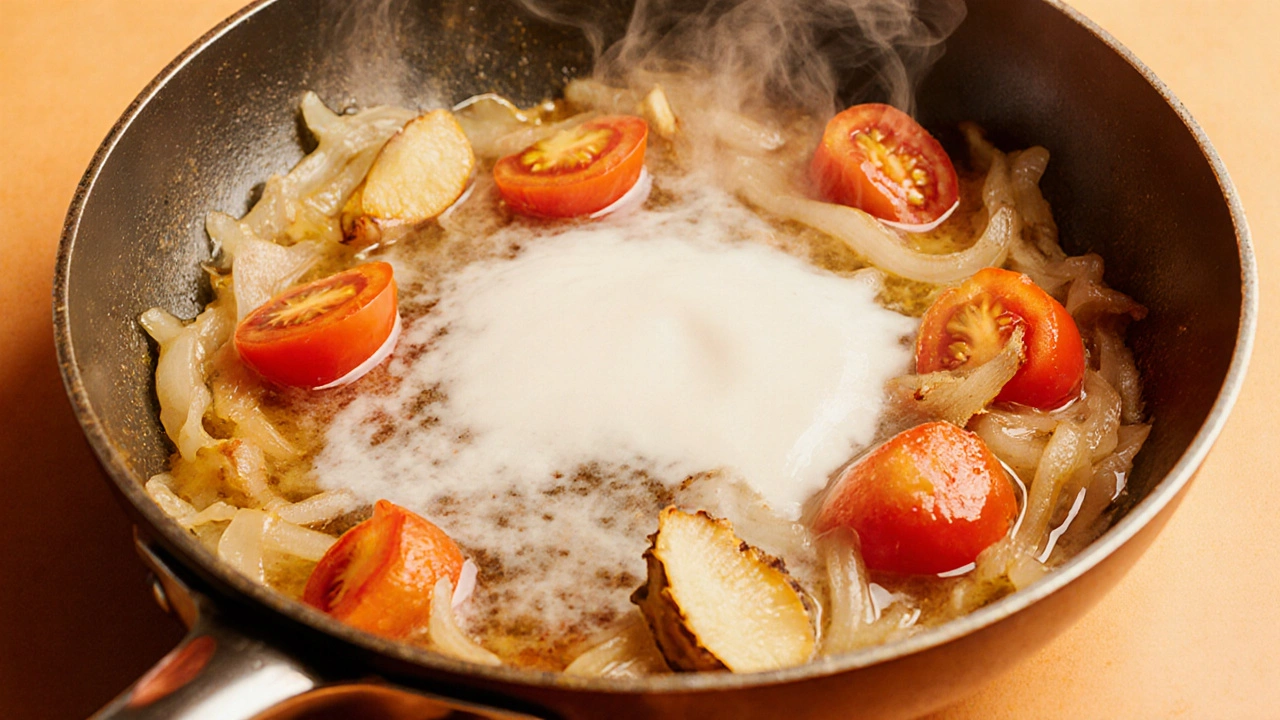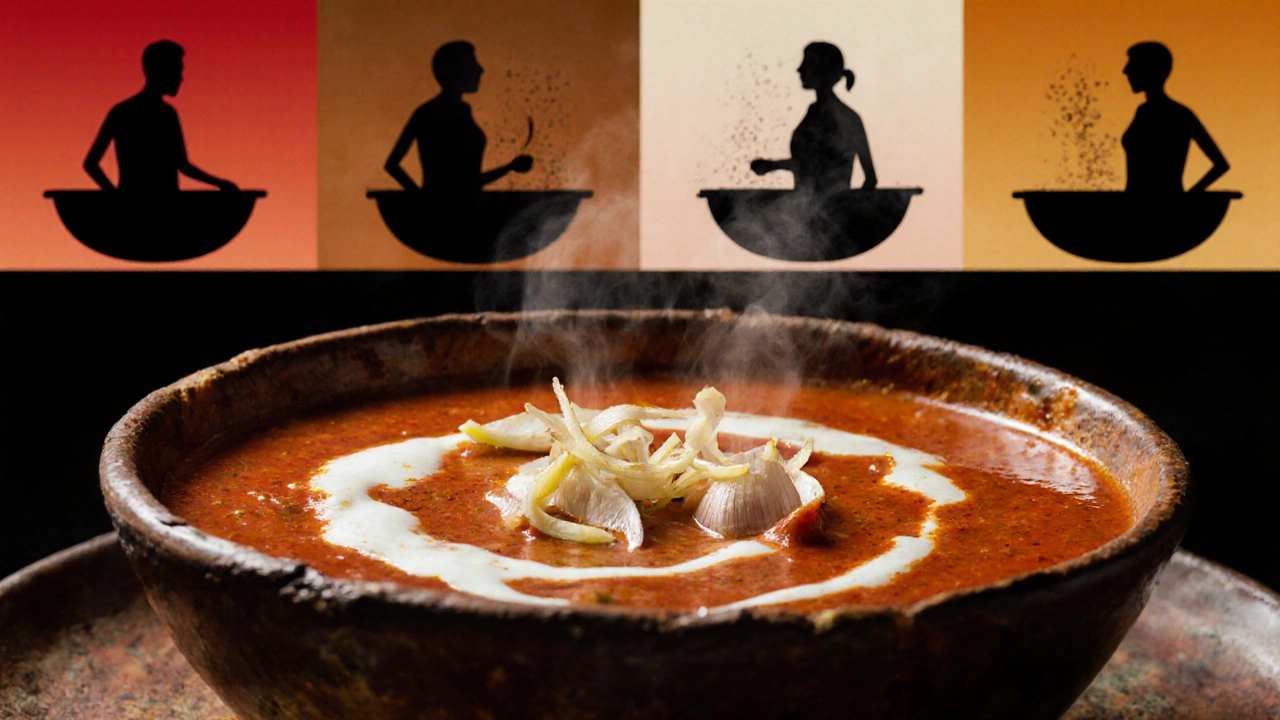Perfect Timing: When to Add Garlic and Ginger to Curry
 Oct, 8 2025
Oct, 8 2025
Garlic & Ginger Timing Guide
Garlic Timing Guide
- Early Temper: Golden, not brown
- Mid Sauté: When onions are translucent
- Late Simmer: Final 5-10 minutes
- Avoid Finish: Raw garlic not integrated
Ginger Timing Guide
- Early Temper: Whole pieces for infusion
- Mid Sauté: After onions soften
- Late Simmer: Final 10 minutes
- Finish: Fresh slice for snap
Key Takeaways
- Garlic releases its sweet depth when added early, but can turn bitter if over‑cooked.
- Ginger shines brightest when added midway, preserving its zing without losing aroma.
- Tempering (tadka) is the golden window for both aromatics in many Indian curries.
- Different curry bases (tomato, coconut, yogurt) dictate slightly different timing.
- Quick reference table at the end lets you pick the right moment for any curry type.
Ever wondered why some curries taste flat while others burst with flavor? The secret often lies in when you toss in two kitchen staples: garlic and ginger. Both bring a punch of aroma, warmth, and health perks, but they behave very differently under heat. Adding them at the wrong stage can mute their impact or, worse, introduce bitterness.
This guide walks you through the science and the kitchen‑tested tricks that let you nail the perfect timing, no matter if you’re whipping up a quick chickpea masala or a slow‑cooked lamb vindaloo.
Understanding Garlic and Ginger
Garlic is a bulbous plant used worldwide for its pungent aroma and health‑boosting compounds. Its key flavor molecules-allicin, diallyl disulfide, and others-activate when the cloves are crushed and heated. Over‑cooking them beyond a light golden hue breaks down these compounds, leading to a sharp, sometimes bitter taste.
Ginger is a rhizome celebrated for its warm, spicy flavor and digestive benefits. The zing comes from gingerols and shogaols, which transform with heat. Gentle sauté preserves their bright snap; prolonged boiling mellows them into a sweet, honey‑like undertone.
Both ingredients belong to the broader family of aromatics that form the flavor backbone of Indian curries. However, each follows its own heat‑reaction curve, which is why timing matters.
Curry Cooking Stages - Where Aromatics Fit
Most Indian curries move through four recognizable phases:
- Temper (tadka) - oil heats, whole spices crackle, and aromatics are introduced.
- Sautée - softened onions, tomatoes, or base vegetables cook down.
- Simmer - main protein or legumes join, broth or water is added, and the pot bubbles gently.
- Finish - herbs, cream, or a splash of lemon are stirred in just before serving.
Each stage offers a different temperature and moisture level, changing how garlic and ginger behave. Below we map the ideal windows.

When to Add Garlic
Early tempering (Stage1) - If you want a deep, caramelized garlic note, add minced or thinly sliced garlic right after the whole spices pop. Keep the heat moderate; a golden color (not brown) signals flavor release without bitterness. This technique works wonders in tomato‑based curries where a sweet‑savory backbone is desired.
Mid‑sauté (Stage2) - For a balance between sweet depth and bright pungency, toss garlic after the onions turn translucent. The residual heat finishes cooking the garlic just enough to mingle with the onion’s sweetness. This is the go‑to method for coconut‑milk curries, where you don’t want garlic to dominate the creamy profile.
Late simmer (Stage3) - Adding garlic in the final 5‑10minutes preserves a sharper bite, perfect for thin, broth‑y curries (e.g., rasam or clear lentil soups). The brief exposure prevents the bitter breakdown that occurs during long simmering.
Avoid adding garlic during the final finish (Stage4) unless you’re making a raw‑garlic garnish. Raw garlic can be too harsh and won’t integrate with the sauce.
When to Add Ginger
Early tempering (Stage1) - Whole ginger sticks or large chunks can be tossed in with whole spices for a subtle infusion. However, finely minced ginger loses its zing quickly, so it’s better saved for later.
Mid‑sauté (Stage2) - This is the sweet spot for most curries. Add grated or finely chopped ginger after the onions soften. The heat releases gingerols, giving the dish a bright, aromatic lift without burning the delicate compounds.
Late simmer (Stage3) - If you desire a mellow, honey‑like backdrop (common in South Indian pork or fish curries), drop ginger in the last 10minutes of simmering. The prolonged gentle heat transforms gingerols into shogaols, rounding out the flavor.
Finish (Stage4) - A sprinkle of julienned ginger just before serving adds a fresh snap, ideal for salads or cold cucumber raita drizzled over a hot curry.
Combined Timing Strategies
When a recipe calls for both garlic and ginger, the classic “ginger‑first, garlic‑later” rule often works:
- Start with ginger during the sauté stage to build a fragrant base.
- Add garlic a minute or two later, letting it brown gently while the ginger continues to release aroma.
This sequence ensures ginger’s heat‑sensitive compounds stay intact while garlic gets just enough caramelization. In fast‑cook stir‑fries, however, you might add them together at the very end to keep both flavors vivid.

Quick Reference Table - Timing by Curry Type
| Curry Type | Garlic Timing | Ginger Timing |
|---|---|---|
| Tomato‑based (e.g., butter chicken) | Early tempering - golden, not brown | Mid‑sauté - after onions |
| Coconut milk (e.g., Kerala fish curry) | Mid‑sauté - when onions are translucent | Mid‑sauté - same step as garlic |
| Lentil dal (e.g., dal tadka) | Late simmer - last 5min | Early tempering - whole pieces |
| Yogurt‑based (e.g., Punjabi chicken curry) | Mid‑sauté - before adding yogurt | Mid‑sauté - same as garlic |
| Clear broth (e.g., rasam) | Late simmer - final 5min | Late simmer - final 10min |
Pro Tips for Maximum Flavor & Health
- Crush garlic cloves with the flat side of a knife before mincing; the cell walls break, releasing more allicin.
- Use a micro‑grater for ginger; fine shreds heat quickly, preserving their zing.
- Add a splash of lemon juice after the final simmer; the acid brightens both garlic and ginger notes.
- If you’re watching oil intake, dry‑roast whole spices first, then add a teaspoon of water to de‑glaze before introducing aromatics.
- For a smoother texture, blend a portion of the cooked garlic into the sauce; this thickens the gravy while keeping the flavor.
Common Mistakes to Avoid
- Cooking garlic over high heat for too long - turns bitter.
- Adding ginger at the very start and letting it burn - loses its fresh snap.
- Using pre‑minced garlic in a dish that requires a slow caramel - you’ll miss the sweet depth.
- Skipping the tempering step entirely - the spice oil base will be dull.
- Overcrowding the pan; if the aromatics steam instead of fry, flavors stay muted.
FAQ
Can I add both garlic and ginger at the very end of cooking?
Yes, but the result will be a sharp, raw flavor rather than the rounded depth you get from sautéing. This works for quick‑cook stir‑fries where you want a fresh punch, but not for slow‑cooked curries where the aromatics should integrate.
Is it okay to use garlic powder instead of fresh garlic?
Garlic powder can substitute in a pinch, but it lacks the nuanced sweetness of fresh cloves. If you use it, add it early (Stage1) and reduce the amount by one‑third to avoid overpowering the dish.
Why does my curry taste bitter when I add garlic too early?
Burnt garlic releases pyrazines that taste bitter. Keep the heat medium‑low and pull the pan off the burner as soon as the pieces turn light golden.
Does ginger lose its health benefits if I cook it for a long time?
Long cooking converts gingerols to shogaols, which are still beneficial-some studies even suggest shogaols have stronger anti‑inflammatory effects. So you won’t lose the health boost; you’ll just change the flavor profile.
What’s the difference between adding garlic at tempering vs. sauté?
Temper‑added garlic gets a quick burst of caramel and merges with the spice oil, giving a deep, sweet undertone. Sauté‑added garlic keeps more of its pungent bite, ideal when you want a balance with other fresh ingredients.
Mastering the timing of garlic and ginger turns an ordinary curry into a flavor‑packed masterpiece. The next time you fire up the pan, remember the stage‑specific cues, and watch your dish come alive with the perfect aromatic punch.